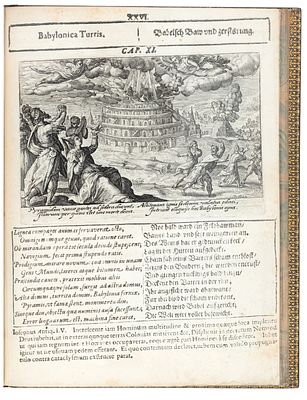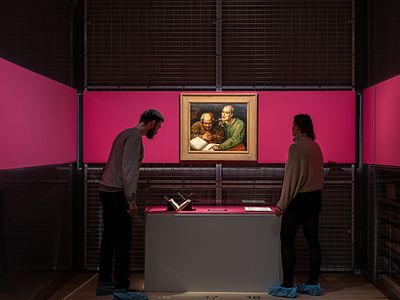IN THE BEGINNING WAS THE WORD
On the Power of Communication
Press Release
IN THE BEGINNING WAS THE WORD
On the Power of Communication
STUDY ROOM | November 6, 2024, to May 4, 2025
IN THE BEGINNING WAS THE WORD explores the role of language in the Bible and its far-reaching significance for communities. The exhibition opens with two biblical stories—the Tower of Babel and the miracle of Pentecost—to illustrate how essential understanding and non-understanding are. Using selected objects from the museum’s collection, the show traces the tension between language and speechlessness, between communication and misinterpretation.
From the Tower of Babel to the Miracle of Pentecost
The first part of the exhibition focuses on the role of language in the Bible. Two central stories show how vital it is to be able to understand each other, at best to speak a common language, and how dire it is if people do not (or no longer) understand each other at all. The Old Testament story of the Tower of Babel, in which the language confusion imposed by God led to insurmountable communication difficulties, is contrasted with the New Testament miracle of Pentecost, in which Jesus’s disciples were given the ability to speak and understand all languages in order to spread the teachings of Christ in a way that everyone could understand. These two very contrasting episodes are brought together thematically in the exhibition to highlight the importance of language and mutual understanding.
Spreading the Bible: Knowledge for Everyone
The second part of the exhibition is dedicated to the dissemination of the Bible and looks at how language contributed to its spread. The translation of the Bible into vernacular languages and the opportunities created by book printing from the mid-fifteenth century onward played a decisive role in the reach of the Holy Scriptures. This development unleashed unimagined forces that still continue to have an impact today. At the time, Bible translations suddenly could be produced and disseminated more quickly, which made knowledge accessible in more and more places and to a much greater number of people—and this also ensured stronger communication and understanding among people.
Language as a Means of Power
Language is a central element of human culture and influences social life in many different ways. The exhibition shows how understanding and non-understanding have also been used to exercise power. In the fifteenth century, for example, Berthold von Henneberg, the Archbishop of Mainz, deliberately issued a censorship edict against the printing of a German-language Bible in order to (continue to) restrict access to the Holy Scriptures. In contrast, Martin Luther pursued the goal of making the Bible accessible to as many people as possible by translating it from Latin into vernacular German. Thus, the Bible itself is a fantastic example of the power and powerlessness of the word, of elitist limitation and mass dissemination of knowledge, of exclusion, access, and inclusion.
Unique Exhibits from the Liberna and Tuliba Collections
The exhibition is based on an impressive variety of themes from the Liberna Collection and the Tuliba Collection, compiled by Bernard Brenninkmeijer and his son Anthony. The collection of early printed Bibles in vernacular languages is particularly remarkable. Among the absolute highlights are six of the eighteen pre-Lutheran German Bibles and a sheet from the Gutenberg Bible. In addition, other valuable objects from the two collections—never exhibited before—will be presented to the public for the first time.


IN THE BEGINNING WAS THE WORD

Tobias Verhaecht (zugeschrieben), Der Turmbau zu Babel, nach 1590

Crispijn van de Passe, Bau und Zerstörung des Turms von Babel, ca. 1612, aus: Guilielmus Salsmann und S. Albani, Liber Genesis [...] Kleve: Jacob van Biesen, 1629

Ziegelstein vom Turm zu Babel, 6. Jh. v. Chr.

Pfingsten, Miniatur aus einem Andachtsbuch, Passau (?), ca. 1525−30, illuminiert vom Meister des Münchner Johannes auf Patmos

Albrecht Dürer, Pfingstwunder (aus: Die Kleine Passion), ca. 1507−1511

Nördliche Niederlande, Delft, Stunden- und Gebetbuch, ca. 1480, illuminiert vom Meister von Beatrijs van Assendelfts Vita Christi und den Meistern der Delfter Halbfiguren

Biblia, sog. Koberger-Bibel, Nürnberg: Anton Koberger, 17.02.1483

Niederländisch?, Biblia Pauperum, ca. 1465

Biblia, sog. Mentelin-Bibel, Straßburg: Johann Mentelin, vor dem 27. Juni 1466
_Herzog%20Anton%20Ulrich-Museum_Braunschweig_Foto_Ursula%20Mangholz.png?locale=en)
Cornelis Anthonisz, Der Fall des Turmes von Babel, 1547

Exhibition view IN THE BEGINNING WAS THE WORD

Exhibition view IN THE BEGINNING WAS THE WORD

Exhibition view IN THE BEGINNING WAS THE WORD